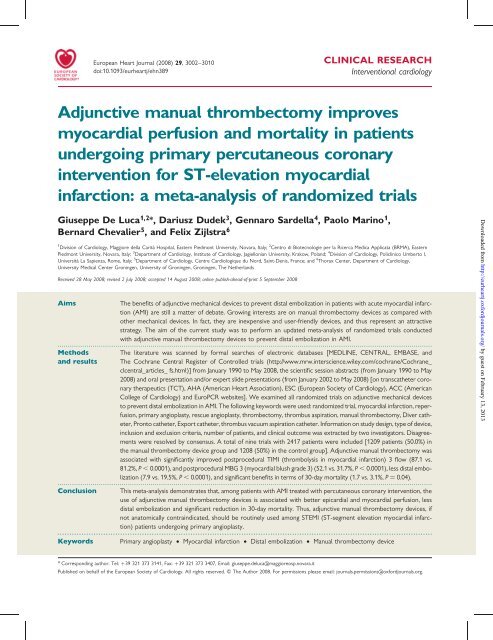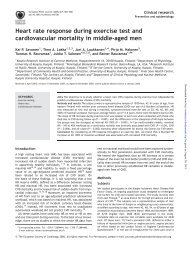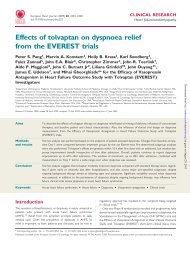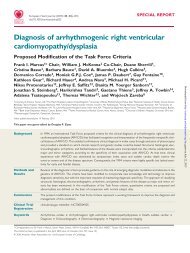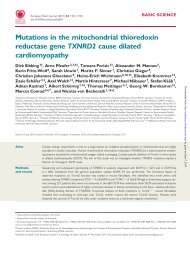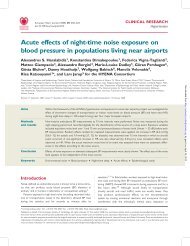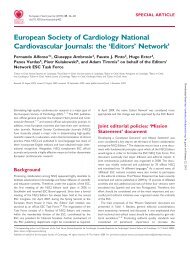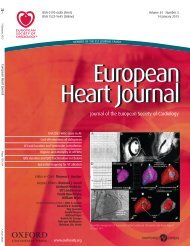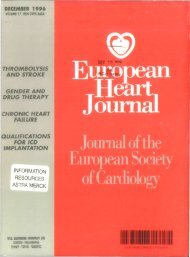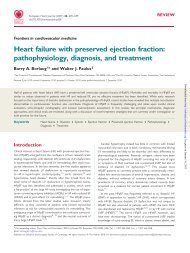Adjunctive manual thrombectomy improves myocardial perfusion ...
Adjunctive manual thrombectomy improves myocardial perfusion ...
Adjunctive manual thrombectomy improves myocardial perfusion ...
You also want an ePaper? Increase the reach of your titles
YUMPU automatically turns print PDFs into web optimized ePapers that Google loves.
European Heart Journal (2008) 29, 3002–3010<br />
doi:10.1093/eurheartj/ehn389<br />
CLINICAL RESEARCH<br />
Interventional cardiology<br />
<strong>Adjunctive</strong> <strong>manual</strong> <strong>thrombectomy</strong> <strong>improves</strong><br />
<strong>myocardial</strong> <strong>perfusion</strong> and mortality in patients<br />
undergoing primary percutaneous coronary<br />
intervention for ST-elevation <strong>myocardial</strong><br />
infarction: a meta-analysis of randomized trials<br />
Giuseppe De Luca 1,2 *, Dariusz Dudek 3 , Gennaro Sardella 4 , Paolo Marino 1 ,<br />
Bernard Chevalier 5 , and Felix Zijlstra 6<br />
1 Division of Cardiology, Maggiore della Carità Hospital, Eastern Piedmont University, Novara, Italy; 2 Centro di Biotecnologie per la Ricerca Medica Applicata (BRMA), Eastern<br />
Piedmont University, Novara, Italy; 3 Department of Cardiology, Institute of Cardiology, Jagiellonian University, Krakow, Poland; 4 Division of Cardiology, Policlinico Umberto I,<br />
Università La Sapienza, Rome, Italy; 5 Department of Cardiology, Centre Cardiologique du Nord, Saint-Denis, France; and 6 Thorax Center, Department of Cardiology,<br />
University Medical Center Groningen, University of Groningen, Groningen, The Netherlands<br />
Received 28 May 2008; revised 2 July 2008; accepted 14 August 2008; online publish-ahead-of-print 5 September 2008<br />
Aims The benefits of adjunctive mechanical devices to prevent distal embolization in patients with acute <strong>myocardial</strong> infarction<br />
(AMI) are still a matter of debate. Growing interests are on <strong>manual</strong> <strong>thrombectomy</strong> devices as compared with<br />
other mechanical devices. In fact, they are inexpensive and user-friendly devices, and thus represent an attractive<br />
strategy. The aim of the current study was to perform an updated meta-analysis of randomized trials conducted<br />
with adjunctive <strong>manual</strong> <strong>thrombectomy</strong> devices to prevent distal embolization in AMI.<br />
.....................................................................................................................................................................................<br />
Methods The literature was scanned by formal searches of electronic databases [MEDLINE, CENTRAL, EMBASE, and<br />
and results The Cochrane Central Register of Controlled trials (http://www.mrw.interscience.wiley.com/cochrane/Cochrane_<br />
clcentral_articles_ fs.html)] from January 1990 to May 2008, the scientific session abstracts (from January 1990 to May<br />
2008) and oral presentation and/or expert slide presentations (from January 2002 to May 2008) [on transcatheter coronary<br />
therapeutics (TCT), AHA (American Heart Association), ESC (European Society of Cardiology), ACC (American<br />
College of Cardiology) and EuroPCR websites]. We examined all randomized trials on adjunctive mechanical devices<br />
to prevent distal embolization in AMI. The following keywords were used: randomized trial, <strong>myocardial</strong> infarction, re<strong>perfusion</strong>,<br />
primary angioplasty, rescue angioplasty, <strong>thrombectomy</strong>, thrombus aspiration, <strong>manual</strong> <strong>thrombectomy</strong>, Diver catheter,<br />
Pronto catheter, Export catheter, thrombus vacuum aspiration catheter. Information on study design, type of device,<br />
inclusion and exclusion criteria, number of patients, and clinical outcome was extracted by two investigators. Disagreements<br />
were resolved by consensus. A total of nine trials with 2417 patients were included [1209 patients (50.0%) in<br />
the <strong>manual</strong> <strong>thrombectomy</strong> device group and 1208 (50%) in the control group]. <strong>Adjunctive</strong> <strong>manual</strong> <strong>thrombectomy</strong> was<br />
associated with significantly improved postprocedural TIMI (thrombolysis in <strong>myocardial</strong> infarction) 3 flow (87.1 vs.<br />
81.2%, P , 0.0001), and postprocedural MBG 3 (<strong>myocardial</strong> blush grade 3) (52.1 vs. 31.7%, P , 0.0001), less distal embolization<br />
(7.9 vs. 19.5%, P , 0.0001), and significant benefits in terms of 30-day mortality (1.7 vs. 3.1%, P ¼ 0.04).<br />
.....................................................................................................................................................................................<br />
Conclusion This meta-analysis demonstrates that, among patients with AMI treated with percutaneous coronary intervention, the<br />
use of adjunctive <strong>manual</strong> <strong>thrombectomy</strong> devices is associated with better epicardial and <strong>myocardial</strong> <strong>perfusion</strong>, less<br />
distal embolization and significant reduction in 30-day mortality. Thus, adjunctive <strong>manual</strong> <strong>thrombectomy</strong> devices, if<br />
not anatomically contraindicated, should be routinely used among STEMI (ST-segment elevation <strong>myocardial</strong> infarction)<br />
patients undergoing primary angioplasty.<br />
-----------------------------------------------------------------------------------------------------------------------------------------------------------<br />
Keywords Primary angioplasty † Myocardial infarction † Distal embolization † Manual <strong>thrombectomy</strong> device<br />
* Corresponding author. Tel: þ39 321 373 3141, Fax: þ39 321 373 3407, Email: giuseppe.deluca@maggioreosp.novara.it<br />
Published on behalf of the European Society of Cardiology. All rights reserved. & The Author 2008. For permissions please email: journals.permissions@oxfordjournals.org.<br />
Downloaded from<br />
http://eurheartj.oxfordjournals.org/ by guest on February 13, 2013
Manual <strong>thrombectomy</strong> devices to prevent distal embolization in AMI 3003<br />
Introduction<br />
A significant improvement in survival has been observed in the last<br />
decades among patients with ST-segment elevation <strong>myocardial</strong><br />
infarction (STEMI) due to the introduction and improvement of<br />
re<strong>perfusion</strong> strategies. 1–3 However, it has been shown that successful<br />
epicardial revascularization is associated with suboptimal<br />
<strong>myocardial</strong> re<strong>perfusion</strong> in a relatively large proportion of patients,<br />
resulting in unfavourable outcomes. 4–5 Mounting interest has<br />
emerged regarding the role of distal embolization as a major determinant<br />
of impaired <strong>myocardial</strong> <strong>perfusion</strong> after primary percutaneous<br />
coronary intervention (PCI). In fact, macroscopic distal<br />
embolization may occur in up to 16% of patients undergoing<br />
primary angioplasty. 6 Previous meta-analyses 7–8 of randomized<br />
trials 9–34 on adjunctive mechanical devices to prevent distal embolization<br />
did not show benefits in mortality, despite significant<br />
benefits in terms of <strong>myocardial</strong> <strong>perfusion</strong> and distal embolization.<br />
However, worse results were observed with mechanical <strong>thrombectomy</strong><br />
devices. In the last years there has been increasing interest<br />
on <strong>manual</strong> <strong>thrombectomy</strong> devices, with several additional trials<br />
recently completed. 35 – 40 In fact, these devices are inexpensive<br />
and user-friendly, and thus represent a very attractive strategy.<br />
However, all the studies were powered for angiographic and electrocardiographic<br />
endpoints but not for hard clinical endpoints,<br />
such as mortality. Therefore, we performed a comprehensive<br />
meta-analysis of all randomized trials on adjunctive <strong>manual</strong> <strong>thrombectomy</strong><br />
devices to prevent distal embolization in patients undergoing<br />
mechanical revascularization for STEMI.<br />
Methods<br />
Eligibility and search strategy<br />
We obtained results from all randomized trials on adjunctive <strong>manual</strong><br />
<strong>thrombectomy</strong> devices to prevent distal embolization in primary<br />
angioplasty for STEMI. The literature was scanned by formal<br />
searches of electronic databases [MEDLINE, CENTRAL, EMBASE,<br />
and The Cochrane Central Register of Controlled trials (http://www.<br />
mrw.interscience.wiley.com/cochrane/Cochrane_clcentral_articles_fs.<br />
html)] from January 1990 to May 2008, the scientific session abstracts<br />
in Circulation, Journal of College of Cardiology, European Heart<br />
Journal and American Journal of Cardiology from January 1990 to<br />
May 2008. Furthermore, oral presentations and/or expert slide presentations<br />
were included [searched on the transcatheter coronary therapeutics<br />
(TCT) (www.tctmd.com), EuroPCR (www.europcr.com), ACC<br />
(American College of Cardiology; www.acc.org), AHA (American<br />
Heart Association; www.aha.org), and ESC (European Society of<br />
Cardiology; www.escardio.org) websites from January 2002 to May<br />
2008]. The reference list of relevant studies was additionally<br />
scanned. Various combinations of the following keywords were used:<br />
randomized trial, <strong>myocardial</strong> infarction, re<strong>perfusion</strong>, primary angioplasty,<br />
rescue angioplasty, <strong>thrombectomy</strong>, thrombus aspiration,<br />
<strong>manual</strong> <strong>thrombectomy</strong>, Diver catheter, Pronto catheter, Export catheter,<br />
thrombus vacuum aspiration catheter. No language restrictions<br />
were enforced.<br />
Inclusion criteria were: (i) randomized treatment allocation and (ii)<br />
availability of complete clinical data. Exclusion criteria: (i) follow-up<br />
data in ,90% of patients; (ii) ongoing studies or irretrievable data;<br />
and (iii) trials including ,50 patients.<br />
Data extraction and validity assessment<br />
Data were independently abstracted by two investigators. Agreement<br />
between investigators was evaluated by Kappa statistics. In case of disagreements,<br />
a third investigator was additionally involved to obtain a<br />
consensus In case of incomplete or unclear data, authors, where possible,<br />
were contacted. The study quality was evaluated by the same two<br />
investigators according to a score, modified from Jadad et al. 41 and<br />
Biondi-Zoccai et al., 42 expressed on an ordinal scale, allocating one<br />
point for the presence of each of the following: (i) statement of objectives;<br />
(ii) explicit inclusion and exclusion criteria; (iii) description of<br />
interventions; (iv) objective means of follow-up; (v) description of<br />
adverse events; (vi) power analysis; (vii) description of statistical<br />
methods; (viii) multicenter design; (ix) discussion of withdrawals; and<br />
(x) details on medical therapy (e.g. antithrombotic regimens) during<br />
and after coronary procedures. Data were managed according to the<br />
intention-to-treat principle.<br />
Outcome measures<br />
Primary endpoint was 30-day mortality. Secondary endpoints were<br />
postprocedural thrombolysis in <strong>myocardial</strong> infarction (TIMI) 3 flow,<br />
<strong>myocardial</strong> blush grade (MBG) 3 and distal embolization.<br />
Data analysis<br />
Statistical analysis was performed using the Review Manager 4.27 freeware<br />
package, SPSS 11.5 statistical package. Odds ratio (OR) and 95%<br />
confidence intervals (95% CI) were used as summary statistics. The<br />
pooled OR was calculated by using a random effect model (The<br />
DerSimonian and Laird method). The Breslow–Day test was used to<br />
examine the statistical evidence of heterogeneity across the studies<br />
(P , 0.1).<br />
Potential publication bias was examined by constructing a ‘funnel<br />
plot’, in which sample size was plotted against ORs (for postprocedural<br />
TIMI 3 flow, angiographic endpoint available from all studies). In<br />
addition, a linear regression approach to measure funnel plot asymmetry<br />
was used. 43 A sensitivity analysis was performed according the type<br />
of publication (abstract only vs. full-length manuscript), population size<br />
(,150 vs. .150 patients) and study quality (higher than median and<br />
median vs. lower than median quality studies). 44<br />
The study was performed in compliance with the quality of reporting<br />
of meta-analyses (QUOROM) guidelines. 45<br />
Results<br />
Eligible studies<br />
Among 458 potentially relevant publications, a total of 20 randomized<br />
trials were initially identified. 9 – 21,32 – 33,35 – 39 Ten trials were<br />
excluded because of evaluation of mechanical <strong>thrombectomy</strong><br />
devices, 9 – 15,18,32 – 33 whereas one trial because of comparison<br />
between two <strong>manual</strong> <strong>thrombectomy</strong> devices 38 (Figure 1). There-<br />
16 – 17,19 – 21,35 – 37,39<br />
fore, a total of nine trials were finally included,<br />
enrolling 2417 patients [1209 patients (50.0%) randomized to<br />
<strong>manual</strong> <strong>thrombectomy</strong> device and 1208 (50%) to conventional<br />
primary PCI]. Kappa statistics showed a good agreement<br />
between investigators in the selection, validity assessment, and<br />
data extraction (Kappa ¼ 0.7). Trials characteristics are shown in<br />
Table 1.<br />
Downloaded from<br />
http://eurheartj.oxfordjournals.org/ by guest on February 13, 2013
3004<br />
Figure 1 Flow diagram of the systematic overview process<br />
(RCT, randomized controlled trials).<br />
Primary endpoint<br />
Data on mortality were available in 2401 (99.4%) out of 2417<br />
patients. As shown in Figure 2, a total of 58 patients (2.4%) died<br />
at 30-day follow-up. <strong>Adjunctive</strong> <strong>manual</strong> <strong>thrombectomy</strong> devices<br />
were associated with significant benefits in terms of 30-day mortality<br />
[1.7 vs. 3.1%, OR (95% CI) ¼ 0.58 (0.34–0.98), P ¼ 0.04,<br />
P het ¼ 0.97]. No potential publication bias was observed by<br />
visual analysis of the funnel plot (Figure 3), and by the mathematical<br />
estimate of the asymmetry of this plot provided by a linear<br />
regression approach. In fact, the intercept of the regression line<br />
did not deviate significantly from zero (a ¼ 20.24, 95% CI<br />
20.58 to 0.33, P ¼ 0.86).<br />
Sensitivity analyses (Table 2) showed that the results were not<br />
influenced by the status of publication, sample size, and study<br />
quality.<br />
Secondary endpoints<br />
Postprocedural thrombolysis in <strong>myocardial</strong> infarction<br />
3 flow<br />
Data on postprocedural TIMI 3 flow were available in 2235 (92.5%)<br />
patients. As depicted in Figure 4, adjunctive <strong>manual</strong> <strong>thrombectomy</strong><br />
devices were associated with a significantly higher rate of postprocedural<br />
TIMI 3 flow [87.2 vs. 81.2%, OR (95% CI) ¼ 1.59<br />
(1.26–2.0), P , 0.0001, Phet ¼ 0.8].<br />
Postprocedural <strong>myocardial</strong> blush grade 3 <strong>perfusion</strong><br />
Data on MBG were available in 2172 patients (89.9%). As depicted<br />
in Figure 5, adjunctive mechanical devices were associated with a<br />
significantly higher rate of postprocedural MBG 3 [52.1 vs.<br />
31.7%, OR ¼ (95% CI) ¼ 2.44 (2.04–2.92), P , 0.0001, P het ¼<br />
0.0003].<br />
Distal embolization<br />
Data on angiographic distal embolization were available in 1207<br />
patients (49.9%). As shown in Figure 6, adjunctive mechanical<br />
devices were associated with a significant reduction in distal<br />
embolization [7.9 vs. 19.5%, OR (95% CI) ¼ 0.30 (0.20–0.44),<br />
P , 0.0001, Phet ¼ 0.24].<br />
Discussion<br />
G. De Luca et al.<br />
The main finding of this meta-analysis is that adjunctive <strong>manual</strong><br />
<strong>thrombectomy</strong> devices are associated with a significant reduction<br />
in 30-day mortality, explained by the significant benefits in epicardial<br />
and <strong>myocardial</strong> <strong>perfusion</strong>, and less distal embolization.<br />
Several randomized trials and a large meta-analysis have shown that<br />
primary PCI provides mortality benefits in comparison with thrombolysis,<br />
mainly due to better and sustained optimal epicardial <strong>perfusion</strong>.<br />
However, despite epicardial recanalization with TIMI 3 flow, suboptimal<br />
<strong>myocardial</strong> <strong>perfusion</strong> may be observed in up to 20–40% of<br />
patients, with a negative impact on long-term survival. 4–5<br />
In addition to microvascular damage, increasing interest, in the<br />
last years, is on distal embolization, 6,46 with several adjunctive<br />
and mechanical therapies being proposed to prevent this complication.<br />
A recent meta-analysis of randomized trials has shown<br />
that adjunctive abciximab administration is associated with a significant<br />
mortality reduction in primary angioplasty for STEMI. 3<br />
Several mechanical devices have been proposed, including distal<br />
or proximal protection devices and <strong>thrombectomy</strong> catheters. 9–40<br />
Recent meta-analyses on these devices 7–8 have shown no benefits<br />
in survival, despite significant benefits in <strong>myocardial</strong> <strong>perfusion</strong> and<br />
distal embolization. However, a trend in mortality benefits was<br />
observed with distal protection devices, whereas a paradoxically<br />
larger mortality was observed with <strong>thrombectomy</strong> devices,<br />
mainly due to the negative results of the AIMI trial conducted<br />
with AngioJet. 15<br />
It must be recognized that <strong>manual</strong> <strong>thrombectomy</strong> devices, by<br />
being inexpensive and user-friendly, represent a very attractive<br />
strategy. This explains the growing interests on these devices<br />
observed in the last years, with several additional randomized<br />
trials being conducted and recently completed. Three trials have<br />
been recently presented at last TCT 2007 held in Washington,<br />
DC, USA, showing benefits in <strong>myocardial</strong> <strong>perfusion</strong> and distal embolization.<br />
35 – 37 Data from the large Thrombus Aspiration during<br />
Primary coronary intervention in Acute <strong>myocardial</strong> infarction<br />
Study (TAPAS) trial have recently been published. 39 In this trial<br />
1072 STEMI patients were randomized before angiography to<br />
<strong>manual</strong> <strong>thrombectomy</strong> (Export catheter) or conventional primary<br />
PCI. The vast majority of patients received Gp IIb–IIIa inhibitors.<br />
This study showed significant benefits in <strong>myocardial</strong> <strong>perfusion</strong> (evaluated<br />
by <strong>myocardial</strong> blush and ST-segment resolution) and a trend<br />
in benefits in 30-day survival. The benefits in <strong>myocardial</strong> <strong>perfusion</strong><br />
were confirmed in almost all the analysed subgroups, even though<br />
larger benefits were intuitively observed especially in patients<br />
revascularized within the first 3 h from symptom onset, when the<br />
amount of <strong>myocardial</strong> salvage is relatively high. One-year follow-up<br />
data have recently been presented at ACC 2008 meeting, 40 showing<br />
significant benefits in survival with <strong>manual</strong> <strong>thrombectomy</strong>.<br />
In our meta-analysis, including nine randomized trials and 2417<br />
patients, we observed that <strong>manual</strong> <strong>thrombectomy</strong> devices were<br />
associated with significant benefits in 30-day survival, explained<br />
by the improvement of epicardial and <strong>myocardial</strong> <strong>perfusion</strong> and<br />
reduction in distal embolization.<br />
Randomized trials conducted so far on mechanical <strong>thrombectomy</strong><br />
devices have failed to show benefits in terms on infarct size<br />
and <strong>myocardial</strong> <strong>perfusion</strong>. Whether the observed benefits in<br />
Downloaded from<br />
http://eurheartj.oxfordjournals.org/ by guest on February 13, 2013
Table 1 Characteristics of randomized trials included in the meta-analysis<br />
Study Period Study device and design Exclusion criteria TCL Primary FU (months)<br />
(number of patients)<br />
endpoints<br />
.............................................................................................................................................................................................................................................<br />
REMEDIA 2004 Diver (n ¼ 50) vs. control<br />
(n ¼ 49)<br />
De Luca et al. 2004 Diver (n ¼ 38) vs. control<br />
(n ¼ 38)<br />
DEAR MI 2004–2005 Pronto catheter (n ¼ 74) vs.<br />
control (n ¼ 74)<br />
Export 2004–2005 Export catheter (n ¼ 24) vs.<br />
control (n ¼ 26)<br />
VAMPIRE 2004–2005 TVAC (n ¼ 180) vs. control<br />
(n ¼ 175)<br />
Export study 2005–2006 Export catheter (n ¼ 120)<br />
vs. control (n ¼ 129)<br />
EXPIRA 2005–2006 Export catheter (n ¼ 88)<br />
vs. control (n ¼ 87)<br />
PIHRATE 2005–2006 Diver (n ¼ 100) vs. control<br />
(n ¼ 94)<br />
TAPAS 2005–2006 Export catheter (n ¼ 535)<br />
vs. control (n ¼ 536)<br />
Ischaemia time . 12 h No MBG/STSR 1<br />
Thrombolytic therapy or Gp IIb–IIIa receptor inhibitor; IRA , 2.5 mm; TIMI 2–3 without large<br />
thrombus; CS<br />
Shock; previous MI; recent thrombolitic therapy; previous bypass surgery; LBBB, severe renal and<br />
hepatic dysfunction; contraindication to glycoprotein IIb–IIIa inhibitors<br />
Yes LV remodelling 6<br />
No STSR/MBG 1<br />
Preprocedural TIMI 3 flow No STSR 1<br />
Prior thrombolysis, cardiogenic shock, cardiac arrest or survivors of cardiac arrest, previous CABG,<br />
chronic renal failure, left main disease, vessel size ,2.5 or .5.0 mm<br />
Pre-cathlab use of thrombolytic therapy or IIb–IIIa antagonist; patients presenting with a cardiogenic<br />
shock (blood pressure ,90 mmHg); patients presenting with cardiac arrest at any time before<br />
intervention; patients previously treated with a pacemaker or with left/right bundle branch block; any<br />
planned use of distal protection device; multi vessel coronary artery disease with planned non-target<br />
artery PCI or treated with emergent coronary artery bypass surgery<br />
Age , 18 years previous AMI or CABG; cardiogenic shock; 3-vessel/left main CAD; severe valvular<br />
heart disease; unsuccessful PCI (no antegrade flow or 50% residual stenosis in the IRA); rescue/<br />
facilitated PCI; contraindication to Gp IIb–IIIa inhibitors; STEMI . 9 h from symptoms onset; native<br />
IRA , 2.5 mm diameter; TS grade , 3; TIMI 2–3 at time of initial angiography<br />
Contraindications to PCI (contrast allergy, no possibility to stent implantation); contraindications to<br />
ASA, thienopirydins or GP IIb/IIIa inhibitors; active bleeding or coagutopathy; prior CABG or PCI;<br />
known ejection fraction EF ,35%; cardiogenic shock/SBP ,90 mmHg, IABP and/or catheloamins<br />
usage; LBBB, pacemaker rhythm; severe calcifications; previous <strong>myocardial</strong> infarction; stroke history;<br />
no future patient cooperation expected; fibrinolysis directly administered before PCI<br />
Performance of a rescue PCI after thrombolysis, the known existence of a disease resulting in a life<br />
expectancy of less than 6 months<br />
by guest on February 13, 2013<br />
http://eurheartj.oxfordjournals.org/<br />
Downloaded from<br />
No MBG 1<br />
No STSR/MBG 1<br />
Yes STR 9<br />
No STR 1<br />
No MBG 12<br />
Manual <strong>thrombectomy</strong> devices to prevent distal embolization in AMI 3005
Table 1 Characteristics of randomized trials included in the meta-analysis (continued)<br />
Study Age (years)<br />
..........................<br />
Male gender (%)<br />
......................<br />
Diabetes (%)<br />
.................<br />
Killip > 1 (%)<br />
.................<br />
Ischaemia time (min)<br />
................................<br />
Gp IIb–IIIa inhibitors (%)<br />
.................................<br />
Stenting (%)<br />
.................<br />
Quality score<br />
TAS Cont TAS Cont TAS Cont TAS Cont TAS Cont TAS Cont TAS Cont<br />
.............................................................................................................................................................................................................................................<br />
REMEDIA 61 + 13 60 + 13 90 77.6 22 18.4 30 28.6 274 + 137 300 + 202 68 63.3 100 100 8<br />
De Luca et al. 67 + 14 65 + 12 71 55.3 23.7 18.4 21 a<br />
28.9 a<br />
456 + 108 432 + 114 100 100 100 100 7<br />
DEAR MI 57 + 13 59 + 14 84 76 21 15 11 5 206 + 115 199 + 124 100 100 99 97 8<br />
Export 58 62 n.r n.r 13 12 25 12 312 + 180 252 + 132 n.r n.r n.r n.r 2<br />
VAMPIRE n.r n.r n.r n.r n.r n.r n.r n.r 294 294 0 0 92.9 94.7 5<br />
Export study 59 + 13 61 + 13 80.8 81.4 16.7 13.2 11.7 10.9 322 + 413 271 + 198 57.1 73.5 100 100 8<br />
EXPIRA 67 + 14 65 + 12 64.7 55.1 22.7 18.4 19.3 a<br />
28.7 a<br />
408 + 54 456 + 108 100 100 100 100 7<br />
PIHRATE 61 + 10 58 + 10 79.4 81.3 11.8 9.8 16.7 8.8 220 + 122 210 + 115 62.2 63.4 99 96.8 6<br />
TAPAS 63 + 13 63 + 13 67.9 73.1 10.6 12.6 9.8 9.4 190 185 93.4 89.9 92.3 92 9<br />
TCL, thrombus containing lesion (as inclusion criteria); TIMI, thrombolysis in <strong>myocardial</strong> infarction; SBP, systolic blood pressure; MBG, <strong>myocardial</strong> blush grade; STSR, ST-segment resolution; LBBB, left bundle branch block; LM, left main<br />
stenosis; IRA , infarct related artery; PCI, percutaneous coronary Intervention; CABG, coronary artery bypass graft; EF, ejection fraction; CS, cardiogenic shock; RD, reference diameter; TVAC, thrombus vacuum aspiration catheter; TS,<br />
thrombus score; TAS, thrombus aspiration; Cont, Control; n.r., not reported.<br />
a Killip class . 3.<br />
by guest on February 13, 2013<br />
http://eurheartj.oxfordjournals.org/<br />
Downloaded from<br />
3006<br />
G. De Luca et al.
Manual <strong>thrombectomy</strong> devices to prevent distal embolization in AMI 3007<br />
Figure 2 <strong>Adjunctive</strong> <strong>manual</strong> <strong>thrombectomy</strong> devices and 30-day mortality, with odds ratios (OR) and 95% confidence intervals (CI). The size<br />
of the data markers (squares) is approximately proportional to the statistical weight of each trial.<br />
Figure 3 Funnel plot of all studies included in the meta-analysis. Sample size of each study was plotted against the odds ratio for 30-day<br />
mortality. No skewed distribution was observed, suggesting no publication bias.<br />
survival with <strong>manual</strong> <strong>thrombectomy</strong> but not other mechanical<br />
devices are strictly depending on device features and performance<br />
or the availability of larger number of trials, is still unknown.<br />
A large-scale controlled randomized trial with the AngioJet in<br />
thrombotic lesions in acute <strong>myocardial</strong> infarction (AMI) is currently<br />
underway in Europe, and will probably provide additional data on<br />
the benefits from mechanical <strong>thrombectomy</strong> devices.<br />
Limitations<br />
This meta-analysis was not performed on individual patient data, as<br />
complete data sets were not available. Caution should be exercised<br />
in the interpretation of the results, given the potential clinical<br />
heterogeneity among trials, due to varying inclusion criteria, definition<br />
of variables, and different <strong>manual</strong> <strong>thrombectomy</strong> devices.<br />
We could not include infarct size as endpoint of the current<br />
meta-analysis due to the unavailability of data and disparity in the<br />
measurement among studies [by enzymes, nuclear scintigraphy<br />
or MRI (magnetic resonance imaging)]. Even if several trials have<br />
not been published as full-length articles yet, a sensitivity analysis<br />
did not show any impact of the publication status on study<br />
results (Table 2). Finally, the large use of Gp IIb–IIIa inhibitors<br />
observed in the vast majority of trials (Table 1), has certainly minimized<br />
the risk of any potential overestimation of the benefits from<br />
thrombus aspiration.<br />
Conclusions<br />
The present meta-analysis has demonstrated that, among patients<br />
with STEMI undergoing primary PCI, the use of adjunctive<br />
Downloaded from<br />
http://eurheartj.oxfordjournals.org/ by guest on February 13, 2013
3008<br />
Table 2 Sensitivity analyses<br />
Subgroup Number Number 30-Day<br />
30-day 30-day P-value P-heterogeneity P-interaction<br />
of studies of mortality Mortality mortality [OR<br />
patients (<strong>manual</strong> (Control) (95% CI)]<br />
<strong>thrombectomy</strong>)<br />
...............................................................................................................................................................................<br />
Overall 9 2401 21/1200 37/1201 0.58 (0.34–0.98) 0.04 0.97 0.82<br />
Published a<br />
5 1629 17/809 31/820 0.55 (0.31–1.00) 0.05 0.79<br />
Unpublished 4 772 4/391 6/381 0.69 (0.22–2.21) 0.53 0.9<br />
Large size (.150 patients) 5 2031 18/1016 31/1015 0.58 (0.32–1.04) 0.07 0.95 0.86<br />
Small size ( 150 patients) 4 370 3/184 6/186 0.56 (0.16–1.99) 0.37 0.6<br />
High study quality 4 1553 17/771 29/782 0.58 (0.32–1.07) 0.08 0.77 0.78<br />
Low study quality 5 848 4/429 8/419 0.56 (0.19–1.62) 0.28 0.88<br />
a As full-length manuscript.<br />
G. De Luca et al.<br />
Figure 4 <strong>Adjunctive</strong> mechanical devices and postprocedural thrombolysis in <strong>myocardial</strong> infarction (TIMI) 3 flow, with odds ratios (OR) and<br />
95% confidence intervals (CI). The size of the data markers (squares) is approximately proportional to the statistical weight of each trial.<br />
Figure 5 <strong>Adjunctive</strong> mechanical devices and postprocedural <strong>myocardial</strong> blush grade (MBG) 3, with odds ratios (OR) and 95% confidence<br />
intervals (CI). The size of the data markers (squares) is approximately proportional to the statistical weight of each trial.<br />
Downloaded from<br />
http://eurheartj.oxfordjournals.org/ by guest on February 13, 2013
Manual <strong>thrombectomy</strong> devices to prevent distal embolization in AMI 3009<br />
Figure 6 <strong>Adjunctive</strong> mechanical devices and distal embolization, with odds ratios (OR) and 95% confidence intervals (CI). The size of the data<br />
markers (squares) is approximately proportional to the statistical weight of each trial.<br />
<strong>manual</strong> <strong>thrombectomy</strong> devices to prevent distal embolization is<br />
associated with better epicardial and <strong>myocardial</strong> <strong>perfusion</strong> and<br />
less distal embolization. These beneficial effects translated into significant<br />
benefits in 30-day survival. Thus, adjunctive <strong>manual</strong> <strong>thrombectomy</strong><br />
devices, if not anatomically contraindicated, should be<br />
routinely used among STEMI patients undergoing primary<br />
angioplasty.<br />
Acknowledgements<br />
All co-authors had full access to all of the data in the study and take<br />
responsibility for the integrity of the data and the accuracy of the<br />
data analysis.<br />
Conflict of interest: B.C. has served as consultant and received a<br />
research grant from Medtronic.<br />
References<br />
1. Keeley EC, Boura JA, Grines CL. Primary angioplasty versus intravenous thrombolytic<br />
therapy for acute <strong>myocardial</strong> infarction: a quantitative review of 23 randomised<br />
trials. Lancet 2003;361:13–20.<br />
2. Zhu MM, Feit A, Chadow H, Alam M, Kwan T, Clark LT. Primary stent implantation<br />
compared with primary balloon angioplasty for acute <strong>myocardial</strong> infarction:<br />
a meta-analysis of randomized clinical trials. Am J Cardiol 2001;88:297–301.<br />
3. De Luca G, Suryapranata H, Stone GW, Antoniucci D, Tcheng JE, Neumann FJ,<br />
Van de Werf F, Antman EM, Topol EJ. Abciximab as adjunctive therapy to re<strong>perfusion</strong><br />
in acute ST-segment elevation <strong>myocardial</strong> infarction: a meta-analysis of randomized<br />
trials. JAMA 2005;293:1759–1765.<br />
4. van’t Hof AW, Liem A, Suryapranata H, Hoorntje JC, de Boer MJ, Zijlstra F. Angiographic<br />
assessment of <strong>myocardial</strong> re<strong>perfusion</strong> in patients treated with primary<br />
angioplasty for acute <strong>myocardial</strong> infarction. Myocardial Blush Grade. Circulation<br />
1998;97:2302–2306.<br />
5. De Luca G, van’t Hof AW, Ottervanger JP, Hoorntje JC, Gosselink AT,<br />
Dambrink JH, Zijlstra F, de Boer MJ, Suryapranata H. Unsuccessful re<strong>perfusion</strong><br />
in patients with ST-segment elevation <strong>myocardial</strong> infarction treated by primary<br />
angioplasty. Am Heart J 2005;150:557–562.<br />
6. Henriques JP, Zijlstra F, Ottervanger JP, de Boer MJ, van’t Hof AW, Hoorntje JC,<br />
Suryapranata H. Incidence and clinical significance of distal embolization during<br />
primary angioplasty for acute <strong>myocardial</strong> infarction. Eur Heart J 2002;23:<br />
1112–1117.<br />
7. De Luca G, Suryapranata H, Stone GW, Antoniucci D, Neumann FJ, Chiariello M.<br />
<strong>Adjunctive</strong> mechanical devices to prevent distal embolization in patients undergoing<br />
mechanical revascularization for acute <strong>myocardial</strong> infarction: a meta-analysis<br />
of randomized trials. Am Heart J 2007;153:343–353.<br />
8. Burzotta F, Testa L, Giannico F, Biondi-Zoccai GG, Trani C, Romagnoli E,<br />
Mazzari M, Mongiardo R, Siviglia M, Niccoli G, De Vita M, Porto I, Schiavoni G,<br />
Crea F. <strong>Adjunctive</strong> devices in primary or rescue PCI: a meta-analysis of randomized<br />
trials. Int J Cardiol 2008;123:313–321.<br />
9. Beran G, Lang I, Schreiber W, Denk S, Stefenelli T, Syeda B, Maurer G, Glogar D,<br />
Siostrzonek P. Intracoronary <strong>thrombectomy</strong> with the X-sizer catheter system<br />
<strong>improves</strong> epicardial flow and accelerates ST-segment resolution in patients with<br />
acute coronary syndrome: a prospective, randomized, controlled study. Circulation<br />
2002;105:2355–2360.<br />
10. Napodano M, Pasquetto G, Sacca S, Cernetti C, Scarabeo V, Pascotto P,<br />
Reimers B. Intracoronary <strong>thrombectomy</strong> <strong>improves</strong> <strong>myocardial</strong> re<strong>perfusion</strong> in<br />
patients undergoing direct angioplasty for acute <strong>myocardial</strong> infarction. J Am Coll<br />
Cardiol 2003;42:1395–1402.<br />
11. Dudek D, Mielecki W, Legutko J, Chyrchel M, Sorysz D, Bartus S, Rzeszutko L,<br />
Dubiel JS. Percutaneous <strong>thrombectomy</strong> with the RESCUE system in acute <strong>myocardial</strong><br />
infarction. Kardiol Pol 2004;61:523–533.<br />
12. Antoniucci D, Valenti R, Migliorini A, Parodi G, Memisha G, Santoro GM,<br />
Sciagra R. Comparison of rheolytic <strong>thrombectomy</strong> before direct infarct artery<br />
stenting versus direct stenting alone in patients undergoing percutaneous coronary<br />
intervention for acute <strong>myocardial</strong> infarction. Am J Cardiol 2004;93:1033–1035.<br />
13. Kuni H, Kijima M, Araki T, Tamaki K, Katoh A, Kubo T, Saitou T, Hirosaka A,<br />
Matsuo H. Lack of efficacy of intracoronary thrombus aspiration before coronary<br />
stenting in patients with acute <strong>myocardial</strong> infarction: a multicenter randomized<br />
trial. J Am Coll Cardiol 2004;43(Suppl. A):245A.<br />
14. Lefevre T, Garcia E, Reimers B, Lang I, di Mario C, Colombo A, Neumann FJ,<br />
Chavarri MV, Brunel P, Grube E, Thomas M, Glatt B, Ludwig J X AMINE ST Investigators.<br />
X-sizer for <strong>thrombectomy</strong> in acute <strong>myocardial</strong> infarction <strong>improves</strong><br />
ST-segment resolution: results of the X-sizer in AMI for neglible embolization<br />
and optimal ST resolution (X AMINE ST) trial. J Am Coll Cardiol 2005;46:246–252.<br />
15. Ali A, Cox D, Dib N, Brodie B, Berman D, Gupta N, Browne K, Iwaoka R,<br />
Azrin M, Stapleton D, Setum C, Popma J AIMI Investigators. Rheolytic <strong>thrombectomy</strong><br />
with percutaneous coronary intervention for infarct size reduction in acute<br />
<strong>myocardial</strong> infarction: 30-day results from a multicenter randomized study. JAm<br />
Coll Cardiol 2006;48:244–252.<br />
16. Burzotta F, Trani C, Romagnoli E, Mazzari MA, Rebuzzi AG, De Vita M,<br />
Garramone B, Giannico F, Niccoli G, Biondi-Zoccai GG, Schiavoni G,<br />
Mongiardo R, Crea F. Manual thrombus-aspiration <strong>improves</strong> <strong>myocardial</strong> re<strong>perfusion</strong>:<br />
the randomized evaluation of the effect of mechanical reduction of distal<br />
embolization by thrombus-aspiration in primary and rescue angioplasty<br />
(REMEDIA) trial. J Am Coll Cardiol 2005;46:371–376.<br />
17. Noel B, Morice MC, Lefevre T, Garot P, Tavolaro O, Louvard Y, Dumas P.<br />
Thromboaspiration in acute ST-elevation MI <strong>improves</strong> <strong>myocardial</strong> re<strong>perfusion</strong>.<br />
Circulation 2005;112(Suppl. II):519.<br />
18. Kaltoft A, Bottcher M, Nielsen SS, Hansen HH, Terkelsen C, Maeng M,<br />
Kristensen J, Thuesen L, Krusell LR, Kristensen SD, Andersen HR, Lassen JF,<br />
Rasmussen K, Rehling M, Nielsen TT, Botker HE. Routine <strong>thrombectomy</strong> in percutaneous<br />
coronary intervention for acute ST-segment-elevation <strong>myocardial</strong><br />
infarction: a randomized, controlled trial. Circulation 2006;114:40–47.<br />
Downloaded from<br />
http://eurheartj.oxfordjournals.org/ by guest on February 13, 2013
3010<br />
19. Silva-Orrego P, Colombo P, Bigi R, Gregori D, Delgado A, Salvade P, Oreglia J,<br />
Orrico P, de Biase A, Piccalò G, Bossi I, Klugmann S. Thrombus aspiration<br />
before primary angioplasty <strong>improves</strong> <strong>myocardial</strong> re<strong>perfusion</strong> in acute <strong>myocardial</strong><br />
infarction: the DEAR-MI (Dethrombosis to Enhance Acute Re<strong>perfusion</strong> in Myocardial<br />
Infarction) study. J Am Coll Cardiol 2006;48:1552–1559.<br />
20. Ikari Y, Kawano S, Sakurada M, Katsuki T, Kimura K, Suzuki T, Yamashita T,<br />
Kuramochi T, Takizawa A, Isshiki T. Thrombus aspiration prior to coronary intervention<br />
<strong>improves</strong> <strong>myocardial</strong> microcirculation in patients with ST elevation acute<br />
<strong>myocardial</strong> infarction, the VAMPIRE Study. Circulation 2005;112(Suppl. II):659.<br />
21. De Luca L, Sardella G, Davidson CJ, De Persio G, Beraldi M, Tommasone T,<br />
Mancone M, Nguyen BL, Agati L, Gheorghiade M, Fedele F. Impact of intracoronary<br />
aspiration <strong>thrombectomy</strong> during primary angioplasty on left ventricular remodelling<br />
in patients with anterior ST-elevation <strong>myocardial</strong> infarction. Heart 2006;92:<br />
951–957.<br />
22. Lefevre T, Guyon P, Reimers B, Fauvel JM, Pansieri M. Evaluation of a distal protection<br />
filter device in patients with acute <strong>myocardial</strong> infarction: The DIPLOMAT<br />
Study. Am J Cardiol 2003;92(Suppl. 6A):37L–38L.<br />
23. Fujita N, Suwa S, Koyama S, Saito M, Muramatsu T. The efficacy of distal embolic<br />
protection device during an acute <strong>myocardial</strong> infarction: early and long-term<br />
results. Am J Cardiol 2004;94(Suppl. 6A):34E.<br />
24. Nanasato M, Hirayama H, Muramatsu T, Unno K, Shimano M, Matsushita T,<br />
Yokota M, Murohara T. Impact of angioplasty with distal protection device on<br />
<strong>myocardial</strong> re<strong>perfusion</strong>. J Am Coll Cardiol 2004;43(suppl.):246A.<br />
25. Rhee I, Gwon HC, Choi JH, Choi JH, Lee SH, Hong KP, Park JE, Seo JD. Distal<br />
protection reduces infarct size after primary angioplasty in acute <strong>myocardial</strong><br />
infarction: magnetic resonance imaging. Am J Cardiol 2004;94(Suppl. 6A):36E.<br />
26. Tahk S-J, Chae IH, Choi S-Y, Gwon HC, Hong GR, Hur SH, Jang YS, Kim KB,<br />
Ku BG, Lee MM, Lee SH, Yoon JH, Yoon MH. The effect of distal protection<br />
on the protection of microvascular integrity during primary stenting in AMI<br />
without glycoprotein IIb/IIIa inhibition. Circulation 2004;110(Suppl. III):760.<br />
27. Stone GW, Webb J, Cox DA, Brodie BR, Qureshi M, Kalynych A, Turco M,<br />
Schultheiss HP, Dulas D, Rutherford BD, Antoniucci D, Krucoff MW,<br />
Gibbons RJ, Jones D, Lansky AJ, Mehran R Enhanced Myocardial Efficacy Recovery<br />
by Aspiration of Liberated Debris (EMERALD) Investigators. Distal microcirculatory<br />
protection during percutaneous coronary intervention in acute ST-segment<br />
elevation <strong>myocardial</strong> infarction: a randomized controlled trial. JAMA 2005;293:<br />
1063–1072.<br />
28. Gick M, Jander N, Bestehorn HP, Kienzle RP, Ferenc M, Werner K, Comberg T,<br />
Peitz K, Zohlnhofer D, Bassignana V, Buettner HJ, Neumann FJ. Randomized<br />
evaluation of the effects of filter-based distal protection on <strong>myocardial</strong> <strong>perfusion</strong><br />
and infarct size after primary percutaneous catheter intervention in <strong>myocardial</strong><br />
infarction with and without ST-segment elevation. Circulation 2005;112:<br />
1462–1469.<br />
29. Hong GR, Kang JH, Bae JH, Park JS, Shin DG, Kim YJ, Shim BS. Effectiveness of<br />
distal protection device on the protection of microvascular integrity assessed<br />
by <strong>myocardial</strong> contrast echocardiography in patients with acute <strong>myocardial</strong> infarction.<br />
Eur Heart J 2005;26(suppl.):347<br />
30. Guetta V. The use of protective filterwire to improve flow in Acute MI (UPFLOW<br />
MI trial). http://www.tctmd.com/csportal/appmanager/tctmd/epcoe?srcId=5&_<br />
nfpb=true&hdCon=1386217&_pageLabel=EPCenterContent&destId=6<br />
31. Guyon P, Dewez MP, Glatt B, Chevalier B, Touche T, Levefre T, Dirsch O,<br />
Royer T. Distal embolization in primary percutaneous transluminal coronary<br />
G. De Luca et al.<br />
angioplasty for acute <strong>myocardial</strong> infarction: a reality with direct consequences<br />
on <strong>myocardial</strong> function. Am J Cardiol 2003;92(Suppl. 6A):38L.<br />
32. Ciszewski M, Pregowski J, Teresinska A. Randomized study on coronary <strong>thrombectomy</strong><br />
for acute <strong>myocardial</strong> infarction with ST segment elevation. Abstract.<br />
Eur Heart J 2006;27(suppl.):771.<br />
33. Nassar YS, Elghawaby H, Elnaggar A. XSIZER compared to Acolysis and conventional<br />
PCI in decreasing NO reflow and major adverse cardiac events in treatment<br />
of STEMI with total native coronary artery occlusion. Abstract. Eur Heart J 2006;<br />
27(suppl.):770.<br />
34. Cura FA, Escudero AG, Berrocal D, Mendiz O, Trivi MS, Fernandez J, Palacios A,<br />
Albertal M, Piraino R, Riccitelli MA, Gruberg L, Ballarino M, Milei J, Baeza R,<br />
Thierer J, Grinfeld L, Krucoff M, O’Neill W, Belardi J PREMIAR Investigators. Protection<br />
of distal embolization in high-risk patients with acute st-segment elevation<br />
<strong>myocardial</strong> infarction randomized controlled trial. Am J Cardiol 2007;99:357–363.<br />
35. Chevalier B, Gilard M, Lang I, Commeau P, Roosen J, Hanssen M, Lefèvre T,<br />
Carrié D, Bartorelli A, Montalescot G, Parikh K. Systematic primary aspiration<br />
in acute <strong>myocardial</strong> percutaneous intervention: a multicenter randomised controlled<br />
trial of the export aspiration catheter. EuroInterv 2008;4:1–7.<br />
36. Dudek D. PIHRATE: a prospective, randomized trial of thromboaspiration during<br />
primary angioplasty in AMI. TCT 2007. http://www.tctmd.com/show.<br />
aspx?id=54608<br />
37. Sardella G. Impact of <strong>thrombectomy</strong> with EXPort catheter in infarct related<br />
artery on procedural and clinical outcome in patients with AMI EXPIRA trial.<br />
TCT 2007. http://www.tctmd.com/show.aspx?id=54624.<br />
38. Sardella G, Mancone M, Nguyen BL, De Luca L, Di Roma A, Colantonio R,<br />
Petrolini A, Conti G, Fedele F. The effect of <strong>thrombectomy</strong> on <strong>myocardial</strong><br />
blush in primary angioplasty: the randomized evaluation of thrombus aspiration<br />
by two <strong>thrombectomy</strong> devices in acute <strong>myocardial</strong> infarction (RETAMI) trial.<br />
Catheter Cardiovasc Interv 2008;71:84–91.<br />
39. Svilaas T, Vlaar PJ, van der Horst IC, Diercks GF, de Smet BJ, van den Heuvel AF,<br />
Anthonio RL, Jessurun GA, Tan ES, Suurmeijer AJ, Zijlstra F. Thrombus aspiration<br />
during primary percutaneous coronary intervention. N Engl J Med 2008;358:557.<br />
40. Zijlstra F. Thrombus aspiration during coronary angioplasty for acute <strong>myocardial</strong><br />
infarction (TAPAS). http://www.cardiosource.com/rapidnewssummaries/acc08.<br />
asp (31 March 2008).<br />
41. Jadad AR, Moore RA, Carroll D, Jenkinson C, Reynolds DJ, Gavaghan DJ,<br />
McQuay HJ. Assessing the quality of reports of randomized clinical trials: is blinding<br />
necessary? Control Clin Trials 1996;17:1–12.<br />
42. Biondi-Zoccai GG, Abbate A, Agostoni P, Parisi Q, Turri M, Anselmi M,<br />
Vassanelli C, Zardini P, Biasucci LM. Stenting versus surgical bypass grafting for<br />
coronary artery disease: systematic overview and meta-analysis of randomized<br />
trials. Ital Heart J 2003;4:271–280.<br />
43. Egger M, Davey Smith G, Schneider M, Minder C. Bias in meta-analysis detected<br />
by a simple, graphical test. BMJ 1997;315:629–634.<br />
44. Egger M, Smith GD. Bias in location and selection of studies. BMJ 1998;316:<br />
61–66.<br />
45. Moher D, Cook DJ, Eastwood S, Olkin I, Rennie D, Stroup DF. Improving the<br />
quality of reports of meta-analyses of randomised controlled trials: the<br />
QUOROM statement. Quality of Reporting of Meta-analyses. Lancet 1999;354:<br />
1896–1900.<br />
46. Eeckhout E, Kern MJ. The coronary no-reflow phenomenon: a review of mechanisms<br />
and therapies. Eur Heart J 2001;22:729–739.<br />
Downloaded from<br />
http://eurheartj.oxfordjournals.org/ by guest on February 13, 2013


